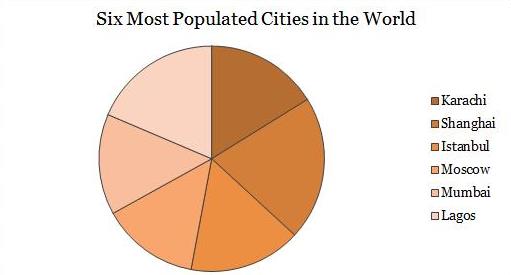The topic we are going to discuss today will fit into visual analytics and data visualization – 101. Though on the surface this is really simple, over the years I have seen many young and sometimes seasoned analysts make this mistake. Hence I feel it is apt for us to discussion the topic about appropriate usage of graphical and visual tools to communicate information and analytical storytelling. To understand this better let us take a simple example and ask the following question: which is a better choice of chart to present information –
Pie Chart or Bar Chart?
To answer this question, let us consider the population of six most populated cities in the world (in alphabetical order)
- Istanbul
- Karachi
- Lagos
- Moscow
- Mumbai
- Shanghai
Here is a task for you – arrange these cities in the descending order of population – take a guess. Please don’t read further till you complete this task. Now, to help you out let me display the actual population of these cities in form of a pie chart, as displayed below.
Before going further, use the above pie chart to rearrange your guess for the cities in descending order of population. Just take a pause and think, how useful is a pie chart to compare the magnitude of the data?
Now, let us plot the same information using a bar chart. You may want to revisit your list and use the following bar chart to rearrange the cities in descending order of population.
Is the bar chart more helpful to rearrange the cities in descending order of population than the pie chart? I think the answer is yes and is fairly obvious. These are the conclusions one could draw:
- Shanghai is definitely on top
- Followed by Lagos at number two
- In terms of population, Karachi and Istanbul are actual quite similar. Karachi’s population is just 0.5% more than Istanbul (statistically not much to choose).
- Mumbai (yeah that’s my city) is at number five followed by Moscow
Sign-off Note
Let me pose a few questions for all of us to discuss
- Why did the bar chart work better than the pie chart?
- What concepts one should keep in mind while presenting information/data to a larger audience?
- Is it even important to convey data in ways that are easy for the audience to understand? Why bother?
You could post your answers / ideas / thoughts / challenges / comments on the ‘Leave a Reply’ section underneath. Let’s discuss.
For further discussion, let me share an unwritten rule among analysts regarding bar charts and pie charts.
For all practical purposes, the rule is to never use pie chart and if you really have to, think for a while and then use bar chart. Does this make sense?




Pie charts are mostly used to represent contributions (pies) – for instance, the contribution of various marketing activities on sales. BTW your bar chart will look even better if you showed it in decreasing order of population (bar heights) – your audience can quickly grab insights out of it
Vineet, that is a very good point about rearranging the bars in order of height – by doing that you are helping your audience – a good practice.
The example values are not very different to each other. This works against the objective of the graphical sector: providing a glance comparison of values.
An upgrade to the bar chart: sort it by the values (major-minor or minor-major) to facilitate comparison.
Thanks for the article, greetings!
Hi..Gr8 Article… Here are my inputs. For the objective shown above, bar chart makes more sense because we are comparing population of different cities. Pie chart could have come in handy if we were to display/compare the weight ages of components which are part of a big unit. i.e lets say population of areas X, Y or Z which are part of the overall population of a country C. Furthermore, the color coding of the pie chart has to be better for more clarity. I agree that bar chart can be reorganized in descending order and same thing has to be done in pie chart.
I always follow this rule, which makes graphs simpler and easy to present.
1) Comparison with “Bar/Column/Line Chart” depends on the data
2) Composition with “Pie Chart” (Mostly)
Most important thing in pie chart is the color of each pie, which should be visible and represent each point. Anything else you want to add?
Sanjib that is a good point that the data drive the type of charts or graphs.Let me share some rules of thumb that often help me, you may find them useful.
For me charts, graphs, analysis or even data come much later. I think the foremost thing of importance is the question these tools are trying to answer. Every dashboard, report, presentation, analysis or model has a business question which it tries to answer. A good practice is to think of it like a story and ask whether the graph or chart is moving the story forward. The opening chapter of this story is of course the question(s). I would recommend to write down the question(s) in plain English before starting with analysis without assuming that everybody knows the question(s).
After that it is an effort to answer the question using the best possible mediums / tools. I am also a huge fan of Japanese minimalist art and similarly I believe the graphics and charts should be simple and to the point – though trust me this is the most difficult and effort intensive part.
Thanks Sir. I completely agree on your views and will try to incorporate these rules in my future tasks definitely.
I like that Roopam left the pie chart and bar chart in the same arbitrary alphabetical order because it demonstrates another common weakness of pie charts: the pie slices are often ordered arbitrarily.
Roopam, I like your example of the problem with pie charts very much. It’s a very convincing demonstration of the fact that the human brain is not accustomed to visually comparing areas. Do you know Stephen Few? He has written a lot about the use(lesness) of pie charts. In fact they are only usefull for two things: to indicate the relative size (part to whole) of a single category. Another one is rather obscure, it involves comparing the sums of several categories. In your example (compare the sums of the number of people in two pairs of cities). See the article on his site Link 1 and Link 2 for extensive discussions. His books are highly recommended. Besides rearranging the categories in descending order you could also transpose the graph. This makes it easier to read the categories. Furthermore you could remove the shading and the grid lines.
pie charts are meant for relative frequency and only when categories are few . Also if sample size is less example total size of sample being 6 and 3 is value of a category then it represent 50 % which is not appropriate to describe for such low sample size.
Bar chart are good as they describe absolute value and are helpful in describing insight when the sample size is small. Also bar charts are good for expressing and undesrtanding difference between two distributions